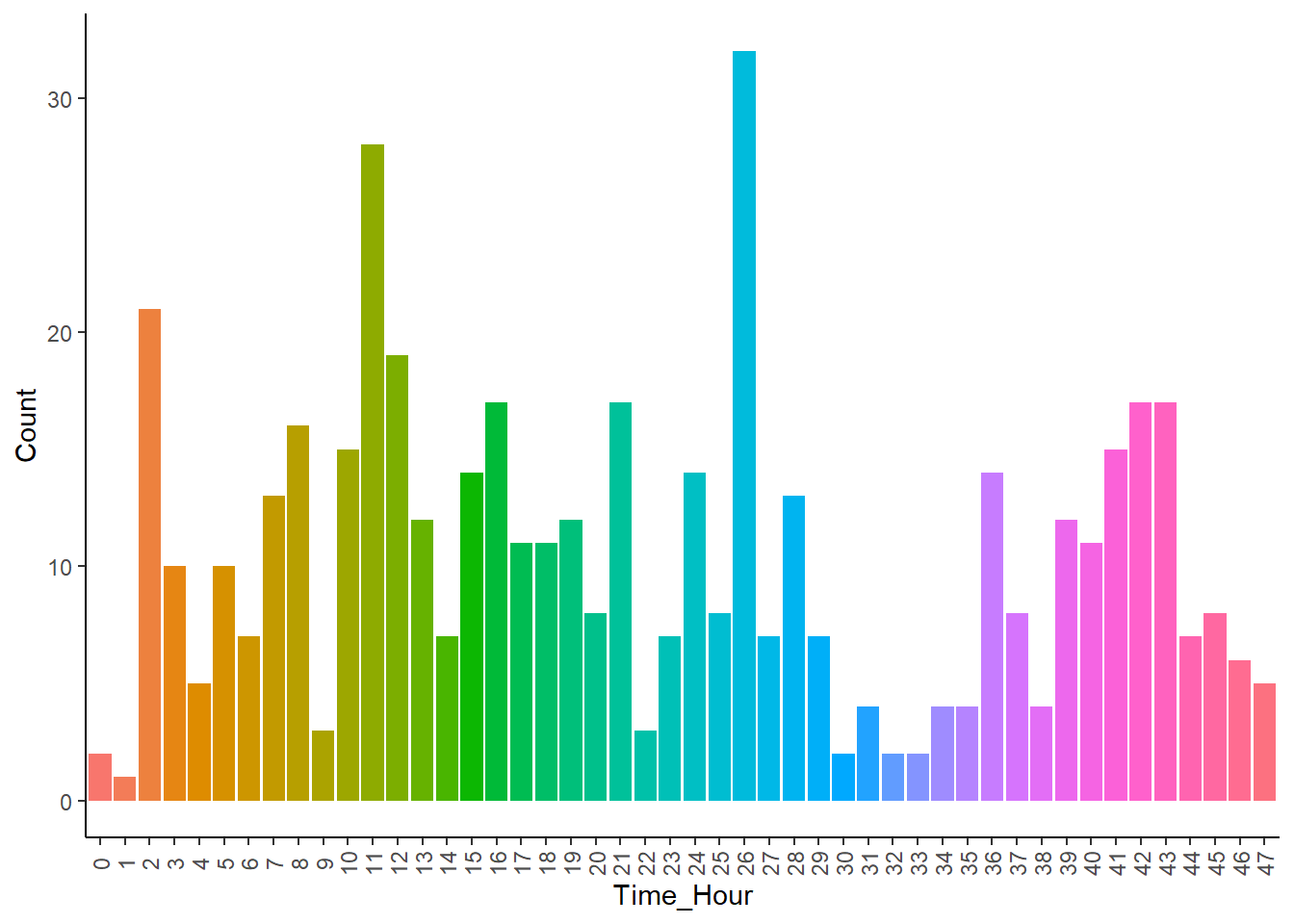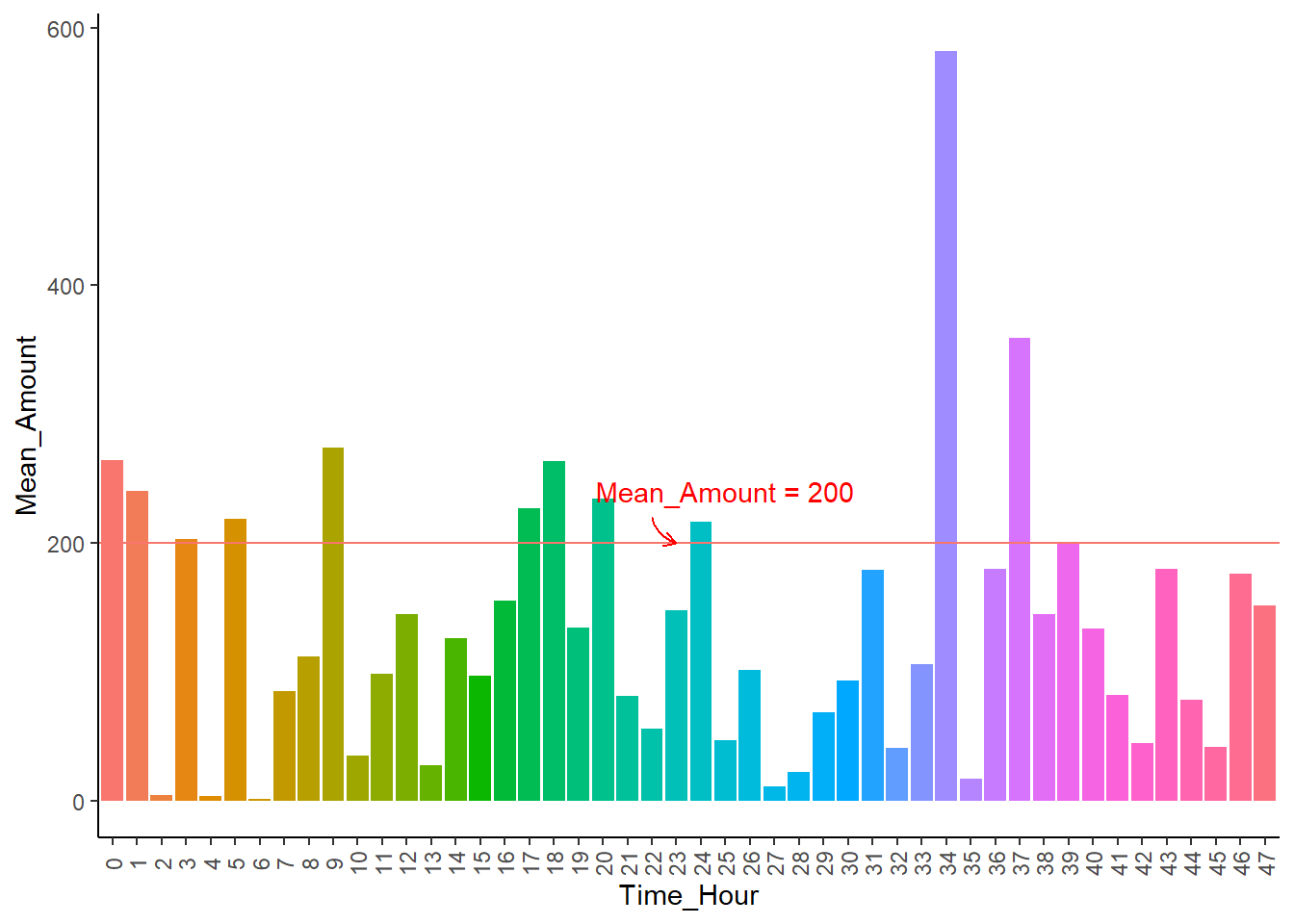数据变量说明
变量说明
class变量:0表示非欺诈,1表示非欺诈。
数据预处理
<- read_csv ("data/creditcard.csv" )<- as.data.frame (card)str (card) # 查看数据基本结构和数据类型
'data.frame': 284807 obs. of 31 variables:
$ Time : num 0 0 1 1 2 2 4 7 7 9 ...
$ V1 : num -1.36 1.192 -1.358 -0.966 -1.158 ...
$ V2 : num -0.0728 0.2662 -1.3402 -0.1852 0.8777 ...
$ V3 : num 2.536 0.166 1.773 1.793 1.549 ...
$ V4 : num 1.378 0.448 0.38 -0.863 0.403 ...
$ V5 : num -0.3383 0.06 -0.5032 -0.0103 -0.4072 ...
$ V6 : num 0.4624 -0.0824 1.8005 1.2472 0.0959 ...
$ V7 : num 0.2396 -0.0788 0.7915 0.2376 0.5929 ...
$ V8 : num 0.0987 0.0851 0.2477 0.3774 -0.2705 ...
$ V9 : num 0.364 -0.255 -1.515 -1.387 0.818 ...
$ V10 : num 0.0908 -0.167 0.2076 -0.055 0.7531 ...
$ V11 : num -0.552 1.613 0.625 -0.226 -0.823 ...
$ V12 : num -0.6178 1.0652 0.0661 0.1782 0.5382 ...
$ V13 : num -0.991 0.489 0.717 0.508 1.346 ...
$ V14 : num -0.311 -0.144 -0.166 -0.288 -1.12 ...
$ V15 : num 1.468 0.636 2.346 -0.631 0.175 ...
$ V16 : num -0.47 0.464 -2.89 -1.06 -0.451 ...
$ V17 : num 0.208 -0.115 1.11 -0.684 -0.237 ...
$ V18 : num 0.0258 -0.1834 -0.1214 1.9658 -0.0382 ...
$ V19 : num 0.404 -0.146 -2.262 -1.233 0.803 ...
$ V20 : num 0.2514 -0.0691 0.525 -0.208 0.4085 ...
$ V21 : num -0.01831 -0.22578 0.248 -0.1083 -0.00943 ...
$ V22 : num 0.27784 -0.63867 0.77168 0.00527 0.79828 ...
$ V23 : num -0.11 0.101 0.909 -0.19 -0.137 ...
$ V24 : num 0.0669 -0.3398 -0.6893 -1.1756 0.1413 ...
$ V25 : num 0.129 0.167 -0.328 0.647 -0.206 ...
$ V26 : num -0.189 0.126 -0.139 -0.222 0.502 ...
$ V27 : num 0.13356 -0.00898 -0.05535 0.06272 0.21942 ...
$ V28 : num -0.0211 0.0147 -0.0598 0.0615 0.2152 ...
$ Amount: num 149.62 2.69 378.66 123.5 69.99 ...
$ Class : num 0 0 0 0 0 0 0 0 0 0 ...
summary (card) # 查看数据的主要描述性统计量
Time V1 V2 V3
Min. : 0 Min. :-56.40751 Min. :-72.71573 Min. :-48.3256
1st Qu.: 54202 1st Qu.: -0.92037 1st Qu.: -0.59855 1st Qu.: -0.8904
Median : 84692 Median : 0.01811 Median : 0.06549 Median : 0.1799
Mean : 94814 Mean : 0.00000 Mean : 0.00000 Mean : 0.0000
3rd Qu.:139321 3rd Qu.: 1.31564 3rd Qu.: 0.80372 3rd Qu.: 1.0272
Max. :172792 Max. : 2.45493 Max. : 22.05773 Max. : 9.3826
V4 V5 V6 V7
Min. :-5.68317 Min. :-113.74331 Min. :-26.1605 Min. :-43.5572
1st Qu.:-0.84864 1st Qu.: -0.69160 1st Qu.: -0.7683 1st Qu.: -0.5541
Median :-0.01985 Median : -0.05434 Median : -0.2742 Median : 0.0401
Mean : 0.00000 Mean : 0.00000 Mean : 0.0000 Mean : 0.0000
3rd Qu.: 0.74334 3rd Qu.: 0.61193 3rd Qu.: 0.3986 3rd Qu.: 0.5704
Max. :16.87534 Max. : 34.80167 Max. : 73.3016 Max. :120.5895
V8 V9 V10 V11
Min. :-73.21672 Min. :-13.43407 Min. :-24.58826 Min. :-4.79747
1st Qu.: -0.20863 1st Qu.: -0.64310 1st Qu.: -0.53543 1st Qu.:-0.76249
Median : 0.02236 Median : -0.05143 Median : -0.09292 Median :-0.03276
Mean : 0.00000 Mean : 0.00000 Mean : 0.00000 Mean : 0.00000
3rd Qu.: 0.32735 3rd Qu.: 0.59714 3rd Qu.: 0.45392 3rd Qu.: 0.73959
Max. : 20.00721 Max. : 15.59500 Max. : 23.74514 Max. :12.01891
V12 V13 V14 V15
Min. :-18.6837 Min. :-5.79188 Min. :-19.2143 Min. :-4.49894
1st Qu.: -0.4056 1st Qu.:-0.64854 1st Qu.: -0.4256 1st Qu.:-0.58288
Median : 0.1400 Median :-0.01357 Median : 0.0506 Median : 0.04807
Mean : 0.0000 Mean : 0.00000 Mean : 0.0000 Mean : 0.00000
3rd Qu.: 0.6182 3rd Qu.: 0.66251 3rd Qu.: 0.4931 3rd Qu.: 0.64882
Max. : 7.8484 Max. : 7.12688 Max. : 10.5268 Max. : 8.87774
V16 V17 V18
Min. :-14.12985 Min. :-25.16280 Min. :-9.498746
1st Qu.: -0.46804 1st Qu.: -0.48375 1st Qu.:-0.498850
Median : 0.06641 Median : -0.06568 Median :-0.003636
Mean : 0.00000 Mean : 0.00000 Mean : 0.000000
3rd Qu.: 0.52330 3rd Qu.: 0.39968 3rd Qu.: 0.500807
Max. : 17.31511 Max. : 9.25353 Max. : 5.041069
V19 V20 V21
Min. :-7.213527 Min. :-54.49772 Min. :-34.83038
1st Qu.:-0.456299 1st Qu.: -0.21172 1st Qu.: -0.22839
Median : 0.003735 Median : -0.06248 Median : -0.02945
Mean : 0.000000 Mean : 0.00000 Mean : 0.00000
3rd Qu.: 0.458949 3rd Qu.: 0.13304 3rd Qu.: 0.18638
Max. : 5.591971 Max. : 39.42090 Max. : 27.20284
V22 V23 V24
Min. :-10.933144 Min. :-44.80774 Min. :-2.83663
1st Qu.: -0.542350 1st Qu.: -0.16185 1st Qu.:-0.35459
Median : 0.006782 Median : -0.01119 Median : 0.04098
Mean : 0.000000 Mean : 0.00000 Mean : 0.00000
3rd Qu.: 0.528554 3rd Qu.: 0.14764 3rd Qu.: 0.43953
Max. : 10.503090 Max. : 22.52841 Max. : 4.58455
V25 V26 V27
Min. :-10.29540 Min. :-2.60455 Min. :-22.565679
1st Qu.: -0.31715 1st Qu.:-0.32698 1st Qu.: -0.070840
Median : 0.01659 Median :-0.05214 Median : 0.001342
Mean : 0.00000 Mean : 0.00000 Mean : 0.000000
3rd Qu.: 0.35072 3rd Qu.: 0.24095 3rd Qu.: 0.091045
Max. : 7.51959 Max. : 3.51735 Max. : 31.612198
V28 Amount Class
Min. :-15.43008 Min. : 0.00 Min. :0.000000
1st Qu.: -0.05296 1st Qu.: 5.60 1st Qu.:0.000000
Median : 0.01124 Median : 22.00 Median :0.000000
Mean : 0.00000 Mean : 88.35 Mean :0.001728
3rd Qu.: 0.07828 3rd Qu.: 77.17 3rd Qu.:0.000000
Max. : 33.84781 Max. :25691.16 Max. :1.000000
round (prop.table (table (card$ Class)),4 )# 查看数据类别比例
分层抽样
处理类别不平衡的数据需要了解的几个概念点:
类别不平衡:指分类任务重不同类别的训练样本树木差别很大的情况。
欠抽样:指某类(样本数占比很大)的样本中抽取出与另一类样本(样本数占比很小)个数一样的样本。即从大类别中抽取与小类别数目一样的样本。
过抽样:指针对样本数占比很小的类别,重新塑造一些数据,使其与另一类数据接近。
对数据进行一些基本转化。
# 把Time列转换为小时 <- card %>% mutate (Time_Hour = round (card[, 1 ]/ 3600 , 0 ))# 把Class列转化为因子型 $ Class <- factor (card$ Class)<- card[card$ Class == "1" , ] # 欺诈样本 <- card[card$ Class == "0" , ] # 非欺诈样本
随机抽取与诈骗样本个数相同的非欺诈样本数据,并与元欺诈样本合并为新的数据。此处使用的欠抽样的方法。
set.seed (1234 )<- sample (x = 1 : nrow (card_0), size = nrow (card_1))<- card_0[index, ]<- rbind (card_0_new, card_1)# 剔除Time列,用Time_Hour列代替。everything()选择所有的变量 <- card_end[- 1 ] %>% select (Time_Hour, everything ())
按照类别进行分层抽样,建立训练集和测试集。
set.seed (1234 )# 按照新数据的目标变量进行8:2 <- createDataPartition (card_end$ Class,p = 0.8 , list = F)<- card_end[index2, ] # 创建训练集 <- card_end[- index2, ] # 创建测试集 # 验证抽样结果,统计三个数据集中正反样本比例是否一致 table (card_end$ Class)
标准化
<- preProcess (card_end, method = "range" ) <- predict (standard, card_end)<- card_s[index2, ]<- card_s[- index2, ]
描述性分析
不同时间诈骗次数-条形图
ggplot (card_1, aes (x = factor (Time_Hour), fill = factor (Time_Hour)))+ geom_bar (stat = "count" ) + theme_classic () + labs (x = "Time_Hour" , y = "Count" ) + theme (legend.position = "none" ,axis.text.x = element_text (angle = 90 ,vjust = 0.5 ))
由图@ref(fig:card-times)可知:
不同时间诈骗金额-箱线图
ggplot (card_1, aes (x = factor (Time_Hour),y = Amount, fill = factor (Time_Hour))) + geom_boxplot () + geom_hline (aes (yintercept = 250 , color = "red" )) + annotate ("text" , x = 6 , y = 500 , label = "Amount = 250" , color = "red" ) + geom_curve (x = 3 , y = 450 , xend = 5 , yend = 250 , angle = 25 , color = "red" ,arrow = arrow (length = unit (0.25 , "cm" ))) + theme_classic () + labs (x = "Time_Hour" , y = "Amount" ) + theme (legend.position = "none" , axis.text.x = element_text (angle = 90 , vjust = 0.5 ))
由图@ref(fig:card-amount)可知:
不同时间平均诈骗金额-条形图
# 提取所需数据 <- card_1 %>% group_by (Time_Hour) %>% summarise (MeanAmount = mean (Amount))ggplot (card_1_mean, aes (x = factor (Time_Hour), y = MeanAmount, fill = factor (Time_Hour))) + geom_bar (stat = "identity" ) + geom_hline (aes (yintercept = 200 , color = "red" )) + annotate ("text" , x = 26 , y = 240 , label = "Mean_Amount = 200" , color = "red" ) + geom_curve (x = 23 , y = 220 , xend = 24 , yend = 200 , curvature = 0.3 , arrow = arrow (length = unit (0.2 , "cm" )), color = "red" ) + theme_classic () + theme (legend.position = "none" ,axis.text.x = element_text (angle = 90 , vjust = 0.5 )) + labs (x = "Time_Hour" , y = "Mean_Amount" )
如图@ref(fig:card-mean)所示:
平均诈骗金额最多的时间段为第二天下午1点,此时间点包含诈骗金额最多的观测。
总体而言,平均诈骗金额普遍在200欧元以内。
自动参数调整调参-使用caret包
参数调整 是提升模型性能的一个重要过程,而大多数机器学习算法都可以至少调整一个参数。复杂的模型通常可以通过调节多个参数值来调整模型从而达到更好的拟合效果。
e.g.,寻找最合适的k值来调整k近邻模型、调节隐藏层层数和隐藏层的节点数来优化神经网络模型;又如支持向量机模型中的调节核函数以及“软边界”惩罚大小等优化。
值得注意的是,如果对所有可能的调参选项均进行尝试,其复杂度非常大,耗时且不科学,需要一种更系统、科学的方式对模型的参数进行调节。
下表列举了使用caret包进行自动参数调整的模型及其参数:
k近邻
knn
k
朴素贝叶斯
nb
fL、usekernel
决策树
C5.0
model、trials、winnow
OneR规则学习器
OneR
无
线性回归
lm
无
回归树
rpart
cp
模型树
M5
pruned、smoothed、rules
支持向量机(径向基核)
svmRadial
C, sigma
随机森林
rf
mtry
更多可调节参数的详细信息
本案例我们使用knn和随机森林两个模型。
我们用iris数据对自动调参的步骤进行演示。
创建简单的调整的模型
set.seed (1234 )<- train (Species~ ., data = iris, method = "C5.0" )
C5.0
150 samples
4 predictor
3 classes: 'setosa', 'versicolor', 'virginica'
No pre-processing
Resampling: Bootstrapped (25 reps)
Summary of sample sizes: 150, 150, 150, 150, 150, 150, ...
Resampling results across tuning parameters:
model winnow trials Accuracy Kappa
rules FALSE 1 0.9353579 0.9019696
rules FALSE 10 0.9370844 0.9045424
rules FALSE 20 0.9325835 0.8976068
rules TRUE 1 0.9382311 0.9062975
rules TRUE 10 0.9407392 0.9099910
rules TRUE 20 0.9385430 0.9066136
tree FALSE 1 0.9347127 0.9009924
tree FALSE 10 0.9369888 0.9044013
tree FALSE 20 0.9332286 0.8985820
tree TRUE 1 0.9375860 0.9053246
tree TRUE 10 0.9399845 0.9088007
tree TRUE 20 0.9392443 0.9076915
Accuracy was used to select the optimal model using the largest value.
The final values used for the model were trials = 10, model = rules and
winnow = TRUE.
由上面的结果可以看出,基于model、trials和winnow三个参数,建立并测试了12个决策树(C5.0)模型,每个模型均给出了精度及Kappa统计量,最下方同时展示了最佳候选模型所对应的参数值。其中Kappa统计量用来衡量模型的稳定性:
很差的一致性: <0.2
尚可的一致性: 0.2~0.4
中等的一致性: 0.4~0.6
不错的一致性: 0.6~0.8
很好的一致性: 0.8~1
定制调参
set.seed (1234 )<- train (Class~ ., data = train_data, method = "rf" ,trControl = trainControl (method = "cv" ,number = 5 ,selectionFunction = "oneSE" ))
Random Forest
788 samples
30 predictor
2 classes: '0', '1'
No pre-processing
Resampling: Cross-Validated (5 fold)
Summary of sample sizes: 631, 631, 630, 630, 630
Resampling results across tuning parameters:
mtry Accuracy Kappa
2 0.9276465 0.8552977
16 0.9314521 0.8628921
30 0.9276627 0.8553120
Accuracy was used to select the optimal model using the one SE rule.
The final value used for the model was mtry = 2.
# 进行预测 <- predict (model_rf, test_data[- 31 ])
# 建立混淆矩阵 confusionMatrix (data = pred_rf, reference = test_data$ Class,positive = "1" )
Confusion Matrix and Statistics
Reference
Prediction 0 1
0 98 7
1 0 91
Accuracy : 0.9643
95% CI : (0.9278, 0.9855)
No Information Rate : 0.5
P-Value [Acc > NIR] : < 2e-16
Kappa : 0.9286
Mcnemar's Test P-Value : 0.02334
Sensitivity : 0.9286
Specificity : 1.0000
Pos Pred Value : 1.0000
Neg Pred Value : 0.9333
Prevalence : 0.5000
Detection Rate : 0.4643
Detection Prevalence : 0.4643
Balanced Accuracy : 0.9643
'Positive' Class : 1
plot (varImp (model_rf)) # 查看变量的重要性
kNN建模
原理
knn,即邻近分类器,就是把未标记的案例归类为与他们最相似的带有标记的案例所在的类。
算法流程:
依次计算测试样本与哥哥训练样本间的距离(常用欧式距离);
将这些距离按照升序排列;
选取距离最小的k(3~10)个训练样本点;
确定这k个点中不同类别的占比;
返回这k个点中占比最大的类别作为测试样本的预测分类。
模型建立
# 创建空向量 <- c ()for (i in 3 : 10 ){set.seed (1234 )<- knn (train_data2[- 31 ], test_data2[- 31 ],$ Class, i)<- table (pred_knn, test_data2$ Class) # 得到混淆矩阵 <- sum (diag (Table))/ sum (Table) # diag()提取对角线的值 <- c (results, accuracy)ggplot (as.data.frame (results), aes (x = 3 : 10 , y = results)) + geom_point ()+ geom_line () + theme_bw () + labs (xlab = " " )
set.seed (1234 )<- knn (train = train_data2[- 31 ], test = test_data2[- 31 ],cl = train_data2$ Class, k = 4 )confusionMatrix (pred_knn,test_data2$ Class, positive = "1" )
Confusion Matrix and Statistics
Reference
Prediction 0 1
0 97 7
1 1 91
Accuracy : 0.9592
95% CI : (0.9212, 0.9822)
No Information Rate : 0.5
P-Value [Acc > NIR] : <2e-16
Kappa : 0.9184
Mcnemar's Test P-Value : 0.0771
Sensitivity : 0.9286
Specificity : 0.9898
Pos Pred Value : 0.9891
Neg Pred Value : 0.9327
Prevalence : 0.5000
Detection Rate : 0.4643
Detection Prevalence : 0.4694
Balanced Accuracy : 0.9592
'Positive' Class : 1
模型评估
# 建立一个数据框,将两个模型预测的结果和真实值放进去。并展示不同预测值 <- data.frame (knn = pred_knn, rf = pred_rf, class = test_data$ Class)<- which (pred_results$ knn != pred_rf)
knn rf class
25 1 0 0
159 1 0 1
160 0 1 1
168 1 0 1
182 0 1 1




